1lumen selects and reviews products personally. We may earn affiliate commissions through our links, which help support our testing.
WildTrail WT90 review
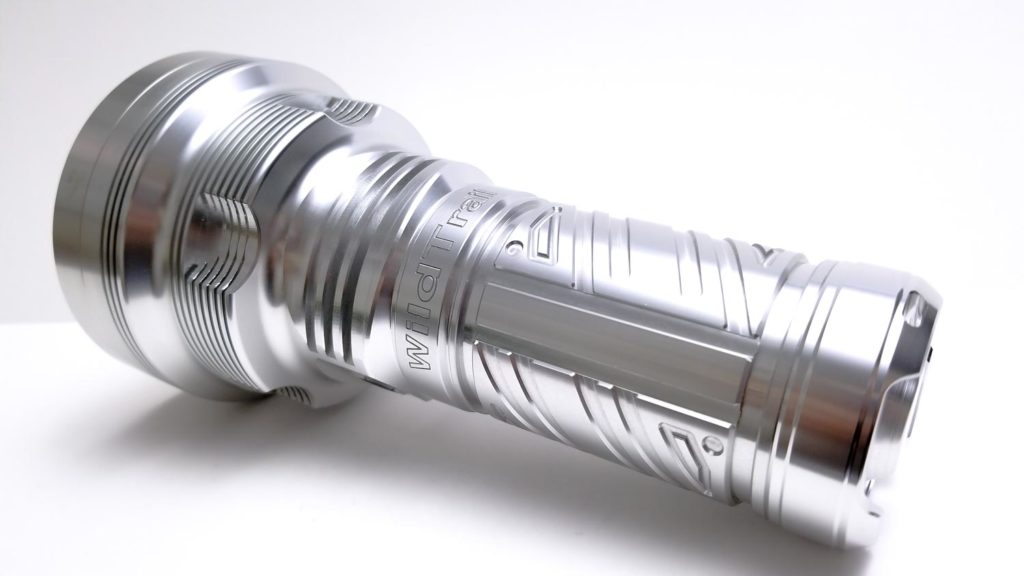
WildTrail WT90 specifications
| Brand/model | WildTrail WT90 |
|---|---|
| LED | Luminus SBT90.2 |
| Lumens | 5,500 lm |
| Beam intensity | 1,000,000 cd / 1Mcd |
| Battery config. | 3*21700 |
| Material | Aluminum |
| Modes | Many, runs NarsilM 1.3 |
| Blinkies | Many! |
| Reflector | Smooth |
| Waterproof | IPX8 |
| Review date | August 2021 |
Introduction:
I had been into the flashlight hobby for a while before I had ever heard of WildTrail. Also known as Chengxin Technology Co. Limited, they are another flashlight OEM thrust into the spotlight in much the same way as Lumintop, Sofirn, and Thorfire: Through collaboration projects with enthusiasts.
These consultations have resulted in lights like the BLF (Budget Light Forum) Q8, A6, FW3A, Gigathrower(s), and the D80-SE. Hold up. D80-SE? Introduced around 2016 and produced by LuckySun, this was a rear-clicky 18650 light, and it was a great alternative to the C8 pattern lights floating around at the time. It was also fully moddable and at around $20 US was a great value.
Fast-forward to 2019, the D80-SE was revived, but this time manufacturing duties were handled by WildTrail. Dubbed the D80V2, it had some nice improvements over the original. Although WildTrail kind of fell off the face of the earth after the D80V2’s popularity waned, they recently burst back onto the scene in a big way with a new light, the WT90 (bonus points if you can guess where the ‘90’ comes from).
The WT90 was developed in partnership with BLF member TexasAce as a multi-cell, ultra long-range thrower designed to be a more compact alternative to the BLF GT90 without losing much performance. It adds 21700 capability and USB type C charging (with power bank) in a pretty fantastic design all for well under $200 (shipped with discounts). WildTrail was nice enough to send one for review, and despite some delays with manufacturing and some bugs to work out, I finally have it, and boy was it worth the 3 month wait! The WildTrail WT90 is barging its way into a pretty crowded room of great throwers, so let’s see if the underdog can one-up the competition.
Package quality.
WildTrail follows the pattern of other third party manufacturers with packaging and presentation, which is fine with me since it keeps the cost down. A box is a box is a box, right? This is not a retail-friendly package so I wasn’t expecting much. The light came in a sturdy, but unassuming large black cardboard box with a lift-off lid. There were no markings, name, or specs of any kind, just a simplistic, but more importantly, functional container. It did its job since the WT90 survived its journey from the Orient without damage. Inside the WT90 was wrapped in plastic and nestled in dense foam for padding. Other than that, there’s not much here:
- WildTrail WT90 flashlight
- Spare o-rings (one for the bezel and 2 for the battery tube)
- User manual
Batteries are not included, and that’s fine because it cuts down on cost for WildTrail so they can sell the light for less Besides, if you’re into lights like this you’ll probably already have some 21700’s lying around. However, you do need “married” batteries for this light, which are matched cells of the same type, capacity, and manufacturer that have always been used together. I would have liked to see a lanyard or other retention device included, and at the very least a USB cable, but again, you probably already have one clogging your junk drawer, under the couch, in your car, etc. Even at this price point, I’m not complaining one iota about the spartan packaging or lack of accessories since this light is still a fantastic value. Fun fact: The user manual was designed courtesy of another BLF member-contributor, Lux-Perpetua. Thanks Lux!



Flashlight in use
Like any large thrower, this is a big light, but with a 99.8 mm head, it is smaller than some similar lights in this category like the BLF GT (135 mm head), Acebeam K75 (126 mm), Astrolux MF04 (135 mm), and MF05 (160 mm). Only the Astrolux MF02S V2 (84 mm) and Acebeam K65 GT (90 mm) are smaller. The body houses three 21700 cells, so it’s a bit thick for small hands, and definitely filled out my big hands.
WildTrail gets major points with me for being bold and adventurous with the design. The body is covered in a very unique machined pattern that’s exceedingly elegant and allows for a good purchase on the body. Unless you had been shaking hands with slime eels, I don’t think you’d lose grip on the WT90. There’s also a virtual forest of heat sinking on this light with very fine cut fins forward of the switch, near the bezel, and thicker ones forward of the battery tube around the switch. There’s very good heatsinking where it’s needed.
The balance is good, and honestly, it feels as good in the hands as a big flashlight can. I had no trouble holding it while taking photos. If you’re used to a ‘soda-can’ form factor light, handling will come naturally. I do think a holster or pouch, or even a shoulder strap would be a nice design addition for this light, and it is missing threads for a tripod mount. The front electronic switch is surrounded by an opaque retaining ring that’s backlit green. It’s set in a flat spot on the head, so it’s easy to find even in the dark. I’m honestly not crazy about the switch action. It’s a little mushy, and the action is pretty low so that doesn’t help either, but it works. The flat tailcap makes tail standing a snap even with the top-heaviness due to that huge bezel and head. I was glad to see some good-sized attachment points for a lanyard on the tail cap. Thanks WildTrail!
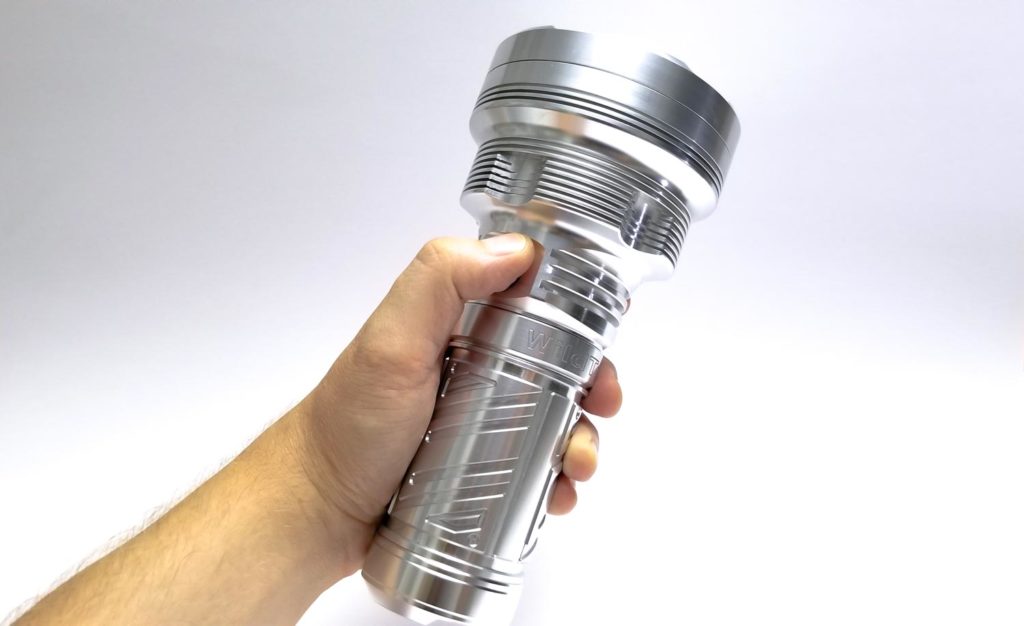


Build Quality, and Warranty
This is my first experience with a WildTrail light, and first impressions are positive. First off, this is a gorgeous light. I mean, you don’t even need to be a flashaholic to appreciate the WT90’s aesthetics. Think of a meticulously-restored 1955 Mercedes 300SL, or 1933 Dusenburg SJ Speedster and you see what I mean.
Constructed from an unidentified aluminum alloy, the WT90 comes in black type III HA anodizing or bare aluminum. My sample was the bare aluminum light, but it is coated with a clear coat to keep the aluminum from oxidizing and staining. The clear coat seems durable, and did have some blemishes on it, but nothing major. There’s no knurling on the light, just the aforementioned milled grooves and patterns for grip. The build quality is very good with no anomalous gaps or uneven joints, the exception being the joint between the top of the battery tube and head. It doesn’t fully seat and there’s a gap large enough to see the top of the o-ring. I don’t think it will hurt the water resistance though since it’s a thick o-ring. Does it pass the maracas test with three 21700s and a carrier installed? Surprisingly it does!
A word about the machining: Overall, it’s very nicely done, especially for such a machine-work intensive light. The WildTrail brand name is even machined into the top part of the battery tube, and there are lots of intricate heatsinking fins, fluting, beveling, and patterns machined into this light. That said, there are obvious machine marks everywhere, but it doesn’t bother me that much because I feel like they give the light character, sort of like a patina on a copper light. Furthermore, since this is a bare light, some finishing steps needed to prep for anodizing like media blasting were omitted. Plus, anodizing naturally covers fine machining marks.
On my sample, there were some abrupt edges on the cell carrier PCB and aluminum contact rings, and obvious burrs and chips of aluminium left over from the machining process, but again, these are usually eliminated during prep for anodizing, so I’m not going to complain too much. I was able to remove them easily with a razor blade and compressed air. However, the sharp edges on the carrier PCB were troubling since when removing or replacing cells in the carrier, you can potentially damage the top part of a battery’s wrapper. This is especially bad because the whole outside of the battery is the negative contact, and a compromised spot so close to the positive terminal can be bad if unchecked (ask me how I know this).
I was informed that WildTrail is aware of this, and they are working on the battery carrier to resolve the sharp edges. I do think it’s worth mentioning that these lights had some production difficulties with shortages of materials (MCU’s and aluminum) and technical issues that were worked out before the second batch of lights were released (the review light is a second production run). I am happy to report that (thanks to the early buyers of the light reporting the faults), the mysterious ‘afterglow’ where the LED glows very faintly even when turned off, is not present in my sample, and neither is the abnormally high quiescent current.
If you’re like me and can’t keep your prying fingers out of things, here’s some good news. There’s no glue, goop, Loctite, hot snot, or silastic sealing the WT90. Everything can be disassembled for maintenance (or modding). The driver is held in with a generous brass retaining ring, and the switch comes out pretty easily. There are o-rings in all the right places: One sealing the bezel, the lens, one on the front of the battery tube, and one sealing the rear. According to WildTrail, this is good enough for IPX8, but they do not recommend immersing the light, so it should be good for splashes, rain, or moisture.
The threads are huge and seem precisely rectangular cut; perfect for a large light. The threads are configured with the head having the external (male) threads and the internal (female) threads on the tube. They are extremely nice, with good smoothness and adequately lubricated. The cell carrier is also nicely constructed and well-made. The positive contacts are short brass buttons, and the negative contacts consist of short springs. WildTrail says the springs (including the driver positive contact) are low-resistance BeCu good for 30 amps. I appreciate that attention to detail.









LED, Lens, Bezel, and Reflector
Figure out what puts the “90” in the WT90? If you guessed the Luminus SBT90 gen 2 then pat yourself on the back and go get a Snickers. This emitter is more legendary than Master Chief. It’s part of Luminus’s specialty white LED lineup meant for industrial and scientific applications. It’s a 3 volt LED and only available in 5700K 70 CRI. The 3×3 mm LES (9 mm2 light emitting surface) sits on a 10×11 mm asymmetrical die with two rows of 12 bonding wires (24 total) connecting the anode and cathode. It’s also domeless, and the whole die is capped by a metal frame with a tiny AR-coated window on top.
The luminance is uniformly distributed and conducive to very high cd/mm2 so it was only a matter of time before flashlight enthusiasts decided to stick it behind a big reflector and see what happened. The rest is history and currently the SBT90.2 is present on some of the highest output, longest throwing flashlights on the market today (Astrolux’s MF05). You get uber amounts of throw combined with high output, so it’s a no-brainer why this emitter is so popular. However, this performance isn’t cheap, at around $50 each (vs. $11 for an Osram Boost HX) so if you’ve ever wondered why lights with the 90.2 are so expensive, well, now you know (and knowing is half the battle).
The 88 mm diameter reflector is very deep with the SBT90.2 perfectly centered with a black centering gasket. It’s not flawlessly smooth, and did have visible lines in it, but it was otherwise unblemished. The bezel is aluminum and is crenulated with the lens set back a ways to protect it from drops. The lens is hardened mineral glass with dual AR coating for maximum light transmission. The beam? Pure thrower, so you get a hotspot that converges into a very tight, intense circle of light, but still maintains ample spill, so it’s somewhat useful for up close work. The beam is not perfectly focused because there’s a flower petal-shaped area of brightness surrounding the hotspot, probably from the window over the emitter die. It’s not too annoying, but it’s there nevertheless. I wouldn’t use it around the house, but on lower settings, it would be fine outdoors for short range tasks (walking, etc.) due to the usable spill. The beam is generally very nice, and at low current it’s a tiny bit green, as is customary of Luminus LEDs, but it goes away at higher currents.


Dimensions and size comparison
- Head diameter: 9.98 cm / 3.92 inches
- Battery tube diameter: 5.6 cm / 2.20 inches
- Overall length: 20.45 cm / 8.05 inches
Weight:
- Without batteries: 752 grams / 26.52 oz, 0.75 kg.
- With three Molicel P42A 21700 cells: 946.3 grams / 33.37 oz, 0.9 kg.
Flashlight size comparison
Group 1 left to right “naked flashlights”: 3D Maglite, WT90, C8.
Group 2 left to right: Acebeam L19, WildTrail WT90, Nightwatch NI03.
Group 3: WT90, Sofirn SP36 Pro. I also compared the WT90 to a Lumintop FWAA for contrast. We can see the WT90 looks huge next to the AA-size FWAA!
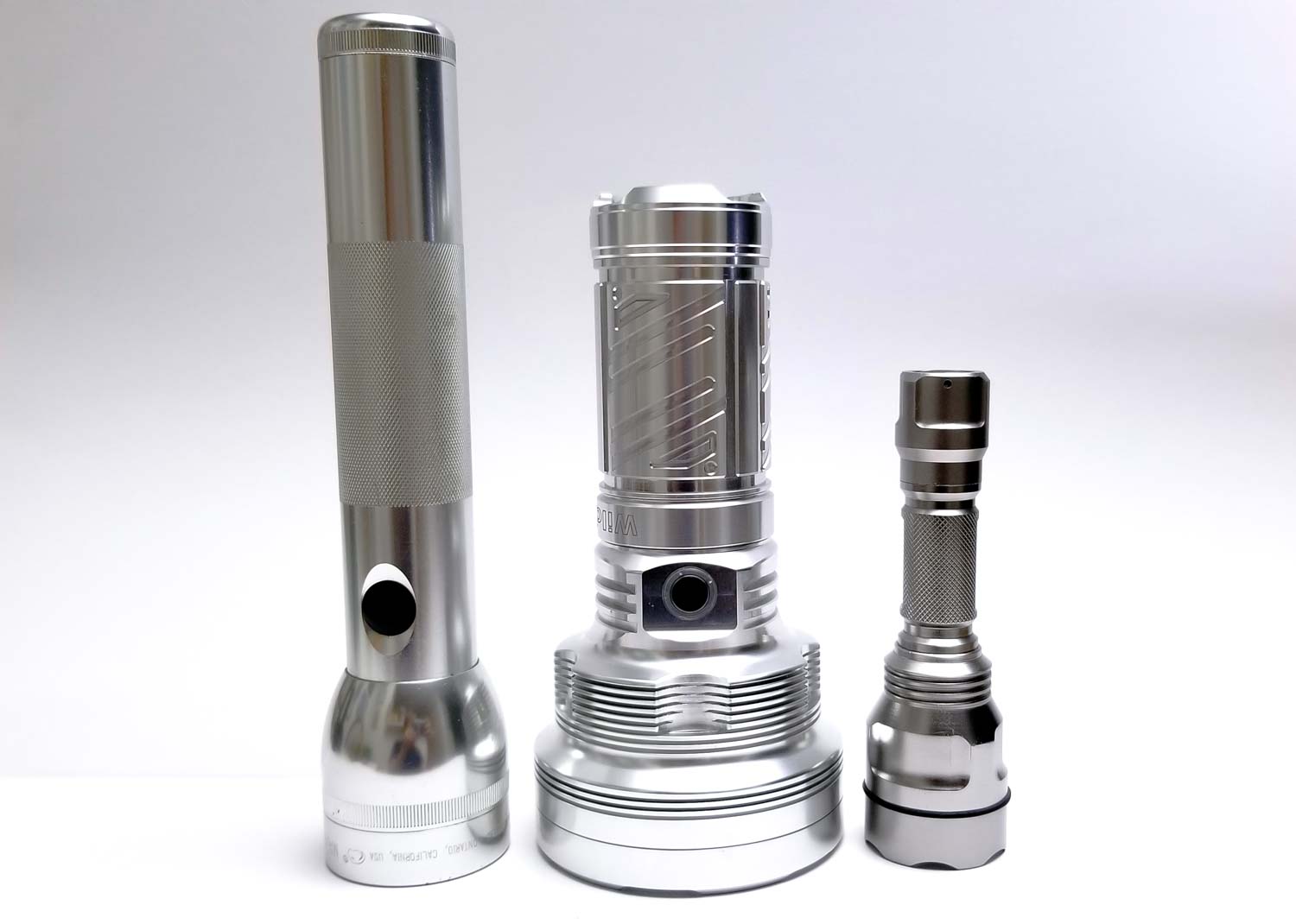
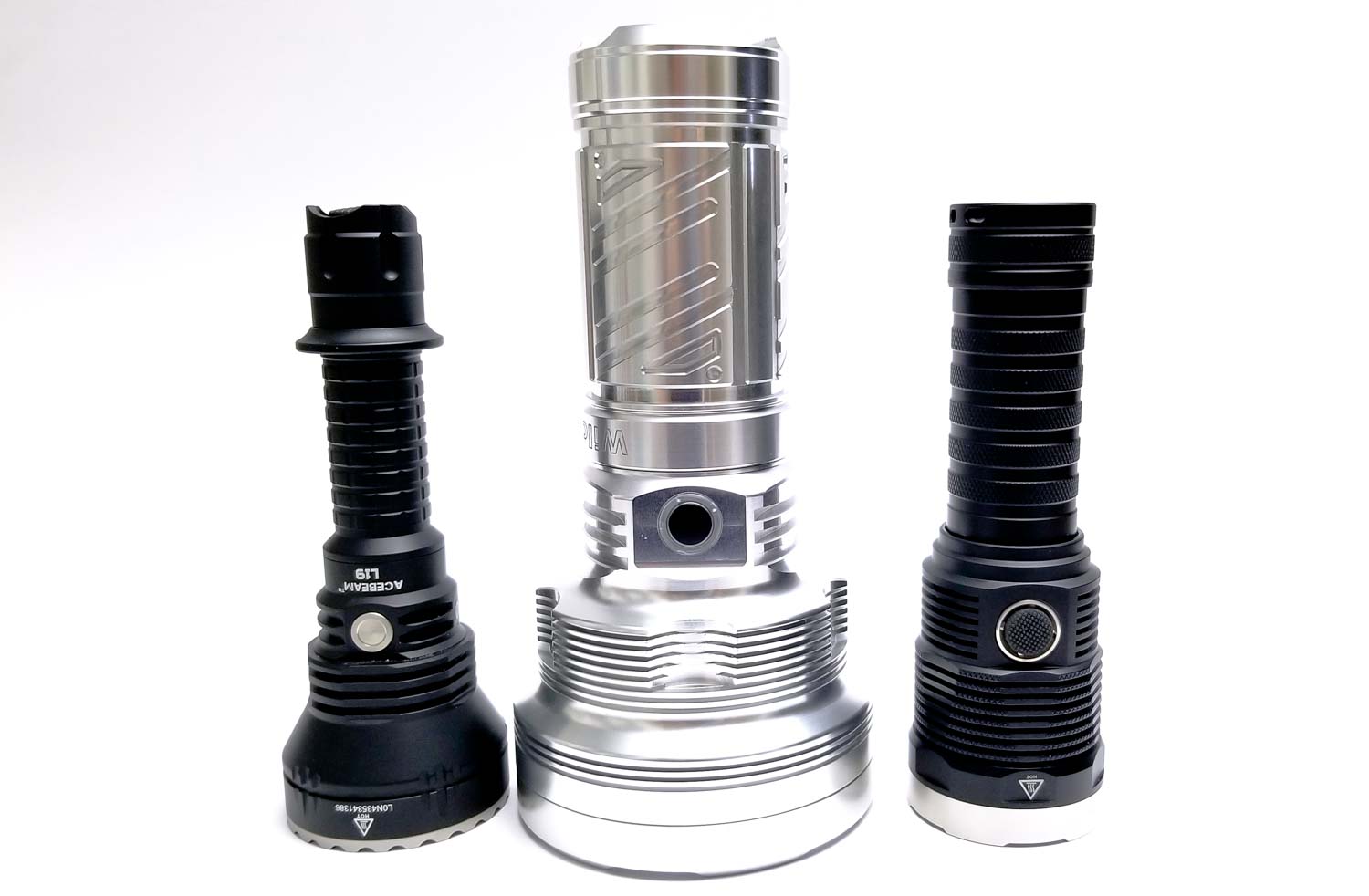
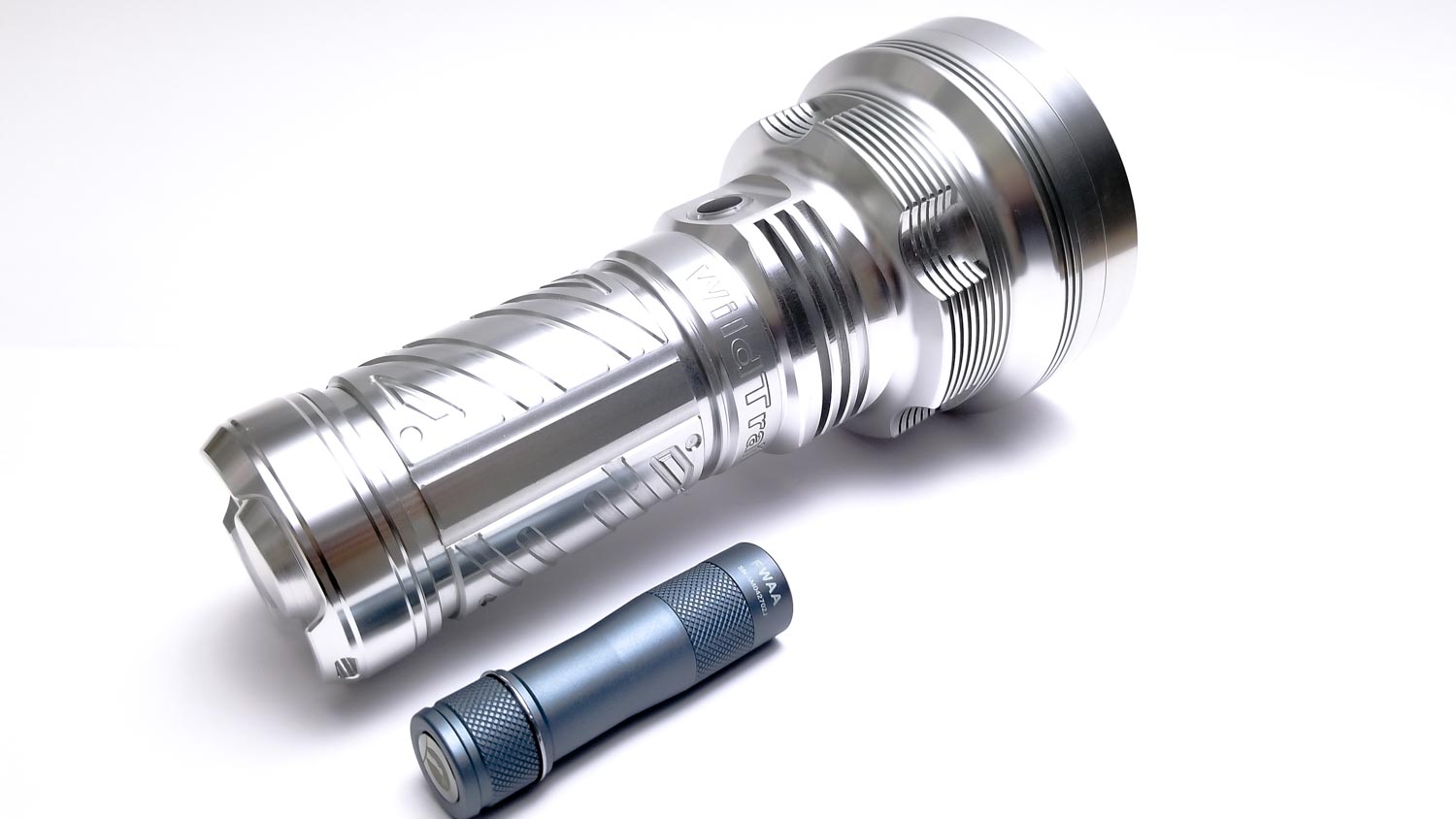
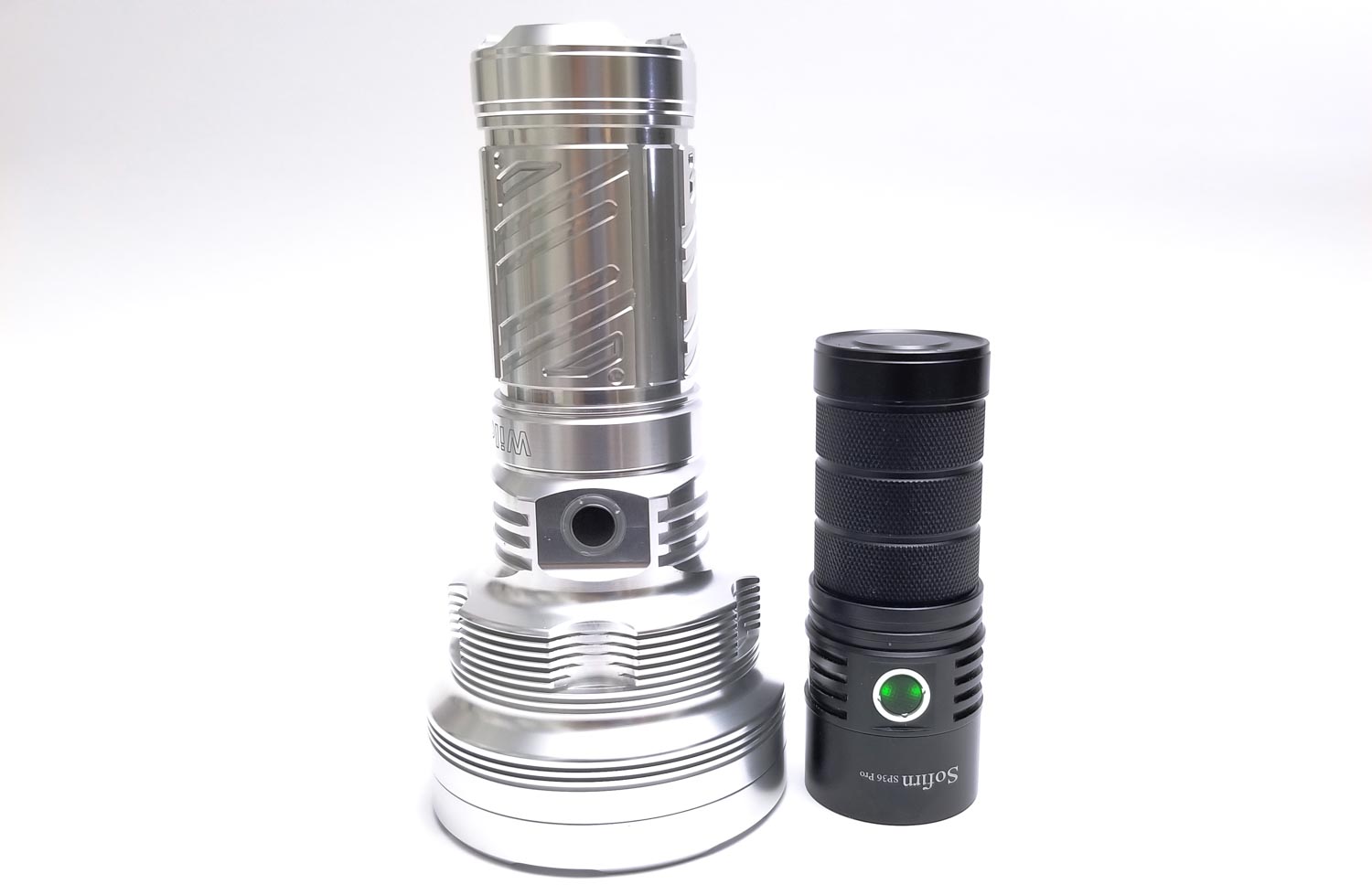
Driver & User Interface:
The WT90 employs a Texas Avenger (love that name) FET driver designed by TexasAce. A unique feature of this driver is it eschews the AMC7135 regulator we typically find in FET+1 drivers and instead uses a resistor bank to approximate 350 mA for lower currents. I’m told this is a more robust and reliable option compared to a 7135 regulator. The FET will deliver as much current as the LED can take, limited only by bottlenecks in the current path (springs, wires, batteries, etc.). This will give you high output with low resistance cells, but the output is not linear and the light will dim as the batteries drain.
The UI was developed by BLF member TomE and is found on other BLF-inspired project lights (the Gigathrower, Q8, and the Astrolux FT03 have it). This is the OG of advanced flashlight UI’s, and if you haven’t guessed already, I’m talking about the other Lord of the Rings-sword-named-UI, NarsilM v1.3. This is a ramping UI with some pretty advanced features (Sigh…back to flashlight UI school for me I guess).
It’s one-click on, one-click off with smooth ramping enabled by default like Anduril, but alternatively has 12 preconfigured mode sets as well (sort of like Biscotti). Other features include temperature regulation with user configured set point or timed step down (choose between 60 sec., 90, sec. 2, 3, 5, or 7-minute intervals (or live dangerously and just completely disable it), five strobe modes, moonlight, momentary, and instant access to Turbo mode. You can also tweak the aux LEDs if the light is so equipped.
Modes: NarsilM can be broken down into 2 user interfaces: By default, it’s set to smooth ramping with an alternative mode set UI with 12 preconfigured modes, sort of like Biscotti. The default UI is by far the simplest and most user-friendly. The mode set UI features a default setting of 4 modes (5 including Moonlight) 0.5%, 5%, 40%, 100% (Turbo). I found this to be a great default value. For simplicity’s sake, I’ll list the basic operations for the default smooth ramping and Mode-set UI below.
From OFF:
- Press and hold: Default ramping UI): Moonlight. Mode set UI: 100% (turbo)
- Single click: Turns on in last mode (same in mode set UI)
- Double click: Turbo (double-clicking again switches to strobe modes, if enabled)
- Triple click: Battery status (blinks out estimated battery voltage like Anduril does)
- 5 clicks: Momentary mode (emulates a forward switch-to disable, unscrew the battery tube)
From ON:
- Press and hold: Default ramping UI: Ramp up (max ramp is 50% of maximum brightness). Mode set UI: Activates Turbo
- Single click: Default ramping UI: Turns off. Mode set UI: Click within 1.2 seconds to switch to the next mode. To turn OFF in Mode set UI: Click after 1.2 seconds in any mode.
- Double click: Default UI: Turbo. Double clicking again in Turbo switches to strobe (if enabled). Mode set UI: N/A
Mode memory:
- Yes, last mode memory is available if enabled (disabled by default)
Low voltage warning:
- Yes. At 3 volts, the light will blink 3 times, then step down, followed by the same pattern after a few seconds. This will repeat a third time, at which point the light will step down to +/- 5% output for a long time before shutting down when the batteries reach 2.8 volts
Strobe/blinkies:
- Yes. There are 5 preconfigured strobe modes which are deactivated by default. To enable strobes, access the configuration settings: In default ramping UI: Click and hold the button for 16 seconds to enter the configuration mode. When you see a double blink followed by a quick flash, release the button. Wait until the light blinks out 4 double flashes (for strobe setting # 4) and click 3 times to enable strobes. In mode set UI: Press and hold the button 3 seconds (on my sample it was more like 7 seconds) and follow the above procedure, except you want setting # 8. Use single-clicks to cycle forward through the different types of strobes:
- 16 Hz
- Dual frequency police strobe
- Bicycle strobe
- 2 second beacon
- 10 second beacon
Lock-out mode:
- Yes. In the default ramping UI, 4 clicks from off will enable the lockout. In the mode set UI, lockout is achieved with a double click followed by a click and hold to lock. Reverse to unlock.
PWM
- Yes! Fast PWM not visible by the naked eye
Additional info: To be frank, I’m coming down with complicatedui-itis with all these advanced interfaces on new lights, but I get it. This is an enthusiast-designed and inspired light, and some folks like the added features and the ability to tweak things to their liking. I like to tweak things too, but I know when to hold ‘em and know when to fold ‘em (insert Kenny Rogers pun here). There are a couple things irking me here: When switching from max ramp to turbo (and back), the light turned off briefly before the switchover. Also, in mode set UI, if you tap the button to switch modes after the mode has locked-in (after 2-3 seconds), if mode memory is disabled, the light won’t switch modes and instead it turns off. Until I realized you need to enable mode memory to fix that, it was pretty annoying.
Some other useful tidbits: In mode-set UI, clicking and holding in any mode for 1.5 seconds will step backwards, which I found to be very useful, while press and hold will activate Turbo. To switch from default to the mode set UI, click and hold the button for 16 seconds to get into the configuration mode. Do not release the button until you see a double flash followed by a short blink. The short blink indicates the first setting, at which point you click the button once to switch to mode-set UI. You can press and hold to skip to the next setting, and a continuous press exits the configuration. When setting the temperature options, if choosing auto step down, the light goes to 100% (it’s best to do this on fresh batteries). Once the light reaches the temperature you’re comfortable with, turn the light off and it remembers that set point. A neat feature NOT found on Anduril/Anduril2 is you can also disable the temperature step down completely.
Messed up the UI and need to start over? Don’t fret or throw your new WT90 out the window! Factory reset is a snap. For default UI: triple-click, then double-click, double-click again (to get into firmware version check), then press and hold for 2 seconds. If successful, you get 4 quick blinks. In mode set UI: Single click, followed by press and hold, double-click, double-click again (for firmware check) the press and hold for around 4 seconds. 4 quick blinks confirms the reset.
NarsilM v1.3 is the one that started it all, and even 5 years on, it’s still up there with Anduril/Anduril2. In fact, it’s closer to Anduril2 since there’s essentially two UI’s at work here. The default setting is probably good enough for most people who buy this light, and I think as-is it’s a great UI. However, for those who live on the edge and wrangle alligators or charm cobras for fun, and like to tinker with discrete brightness settings, thermal control, etc. the mode-set UI is available to satisfy your cravings.
Batteries & Charging
One of the features implemented on the WT90 included three 21700 cells in parallel for power. While most of the competitors make due with 18650 cells, 21700 cells can offer considerably higher capacity and current-handling, plus, there’s only 3 instead of 4 or 8. For maximum output and best results, high discharge cells (minimum 20 amp-rated) are recommended. Lower-discharge cells will work, and you can even run it with a single cell, but at reduced output. WildTrail specifies a minimum and maximum cell length of 70 and 71.5 mm (respectively), so protected cells or ones with integrated charging are a no-go. For best results stick to flat tops. Button tops? My Epoch button-top Samsung 50Gs fit, but were very tight and smooshed the springs pretty bad. Unlike some of the rivals, you aren’t limited to proprietary or button-top only cells. Any 21700 that fits will work.
The cells are housed in a battery carrier, which can be removed from the battery tube for swapping cells or charging. Yep, you heard me right,charging because this isn’t an ordinary carrier. It’s pretty advanced with reverse-polarity MOSFETS and LVP built-in (set to cut the power at 2.9 volts), it features integrated USB type C charging and power bank functionality. The USB type C port is on the side of the top of the carrier and easy to access. WildTrail recommends a charger capable of 3 amps for proper charging. How functional is it? Charging is a pretty standard 2.5 amps max, and while that seems fast, with 3 cells in parallel, that’s around 833 mA per cell, so charging with 5000 mAh cells would still take forever and a day. However, you do get up to 2 amps on the power bank. With 3 discharged Samsung 30T 21700s, my USB tester showed 2.02 amps at around 5.26 volts, so around 10 watts. On the power bank side, I plugged it into another PD-capable power bank and it charged at 5 volts and around 1.7 amps.
The carrier features a pretty clever arrangement for the charging and battery status LEDs also. There’s a ring of 3 LEDs under an opaque circular cover on the center section of the carrier for status: Solid red for charging with a blinking red LED, solid blue (yeessss) for discharging in power bank mode, and a third for battery level. The battery level indicator displays battery voltage via flashes: <25% 1 flash, 25-50% 2 flashes, 50-75% 3 flashes, 75-99% 4 flashes, and 100% is indicated by a solid LED (no flashing). While charging, there’s a solid red LED and an intermittently flashing red LED that turns solid after charge termination. My multimeter showed 4.19 volts on fully charged Samsung 30Ts.
I like this carrier setup, but it’s not perfect. Aside from the show charging, removing the cells is tricky and I ended up damaging the upper part of the battery wrap on a few occasions, especially with the semi-recessed top contact of the 30T as the insulator ring hung up on the brass top contacts. It’s good exercise for your fingers because the proper way to get the cells out is to press down and fully compress the spring when removing the cell to prevent it from catching on the contact. It isn’t so bad with cells with raised tops like the P42A though as they slide out easier.






Performance
The WT90 features an LED that has been passed through a lot of reviewer’s hands in various lights, so we know its performance capabilities. I’m not expecting to be too surprised at the results, but you never know! It’s a FET light and rumor has it WildTrail spared no expense in the electronics selection, so there should be a Infineon FET in there…
Amp measurement
Measuring the current on this light is tricky since the current measurements cannot be taken with the carrier installed in the light. I had to solder a 16 gauge wire to the positive contact of the carrier and wrap the other end around the positive spring on the driver. Then I was able to take the readings like usual, with a piece of 12 gauge wire connecting the negative contact of the carrier to the contact ring of the driver. I used my FY219 clamp meter for the measurements. Tested with fully charged Samsung 30T cells at turn-on:
- Moon: N/A (clamp meter couldn’t read that low)
- 0.5%: 0.03 A
- 5%: 0.23 A
- 15%: 1.58 A
- 25%: 3.15 A
- 50%: 8.26 A
- 100%: 23.87 A
The Turbo measurement is probably a bit low since there would be less resistance in real-world use. The parasitic draw measurement was taken from the carrier. As previously mentioned, there was an issue with high parasitic draw (up to 9 mA) on the first release of the WT90, but it seems like they have fixed that for this copy because I got 0.23 mA with the switch indicator lights activated on this one.
Runtime graph
Uh oh! My integrating sphere was too small for the 99.8 mm head of the WT90, so I built a integrating tube from some PVC plumbing parts: A 4 inch to 3 inch 90-degree closet elbow, two 3 inch street 90’s, and an end cap, calibrated with lights of known output with the Digi-Sense 20250-00 data logging lux meter. I used Molicel P42A 4200 mAh 21700s, fully charged on the carrier, and tested mode set UI group 6 with settings 25%, 50%, and 100% (Turbo). The other modes would have run forever, so I skipped them. I didn’t want to limit the light with a timed step down, so I ran the test with it disabled.



100% (Turbo) started at a hair over 5500 Lumens, and started dropping within a few seconds, but looking at the graph, we can see it’s holding 5000+ Lumens for 2 minutes. Woah. You’d think it would be hotter than a rooster in a henhouse, but nope; the temp rose from ambient 26 C to 46 C in 2 minutes. Better yet, the light holds over 4000 Lumens for nearly 10 minutes total, but by then, the host is heat saturated and has become too hot to hold at over 68 C on the head and 53 C at the tube. There isn’t much of a stepdown in output until the 33 minute mark, when the output drops to under 2000 Lumens and drops again 38 minutes to under 600 Lumens. At the 47 minute mark, the LVP kicks in and drops the output very low with the lux meter reading about 30 Lumens. The light ran this way for a while until I ended the test at the 2 hour, 46 minute mark. The batteries read 2.9 volts at the end of the test.
The 50% brightness mode started at 2722 Lumens and held that for a few minutes. The sustainability goodness continues for this mode (like with Turbo) also, holding over 2500 Lumens for almost 16 minutes! For temps, from ambient 28 C (warm day), I saw 38 C after 60 seconds, and at 5 minutes it’s 55.3 C. The output was pretty steady for the next 30 minutes at 2000 Lumens or better, until a big step down at 1 hour 22 minutes to 580 Lumens (just like Turbo) as the output started dropping due to voltage sag. This was similar behavior to Turbo, with the same graduated steps as LVP kicks in. At 1 hour 35 minutes, the output dropped very low and I ended the test at 2 hours 10 minutes.
25% started at 1452 Lumens and the output didn’t drop much for the next 20 minutes. The first gradual step downs happened at 21 minutes, then again at 41 minutes, 58 minutes, 1 hour 23 minutes, 1 hour 51 minutes, and at 2 hours 19 the output dropped below 1000 Lumens for the first time. The heat was totally tolerable at under 46 C. The step down to 580 Lumens happened at 3 hours 14 minutes, with LVP pulling the reins in at 3 hours 34 minutes. I ended the test at 4 hours 18 minutes when the output dropped very low.
Conclusion? The WildTrail WT90 is pretty, well, wild. In fact, after the Turbo test, I opened the tube to extract the carrier and was greeted by the magic smoke aroma of roasted electronics. The underside of the lens also had a hazy spot in the middle about the size of a penny (it went away after I opened up the tube though…probably condensation). The light still worked fine, so I’m not sure if it was due to things getting too hot and degassing? Either way, a couple of poignant observations about this light. The heat sinking is incredible and makes me wonder why anyone is okay with putting an SBT90.2 in a small host (just kidding, I know why). There is no replacement for thermal mass and surface area, and the WT90 has both, so I have no qualms about leaving the temperature step down turned off. The runtimes aren’t remarkable, but still respectable, and with higher capacity cells, it would only get better. All in all, a very impressive performance here. Every bit as good as it’s competitors. Not many lights can sustain 5000 Lumens for 2 minutes and 4000 for 10, like the WT90 can. LVP works fine also, and I don’t know if NarsilM or the carrier controls that, but I’m guessing the UI controls the flashlight, and the carrier’s LVP is for the power bank.
Lumen measurements (for each mode)
For the lumen tests, I used my home made integrating tube using the Digi-Sense 20250-00 data logging lux meter. I used the mode set UI group 6 and used fully charged Samsung 30T 3000 mAh batteries for the test. All readings recorded at 30 seconds.
| Mode | Measured Lumens | Specified |
|---|---|---|
| Moon | 3.6 lm | ? |
| 0.5% | 15 lm | ? |
| 5% | 130 lm | ? |
| 15% | 875 lm | ? |
| 25% | 1452 lm | ? |
| 50% | 2904 lm | ? |
| 100% | 5336 lm | 5500 lm |
| 100% at start | 6026 lm | – |
WildTrail doesn’t advertise output figures, so I don’t have a benchmark to compare to, but honestly these numbers aren’t surprising given the characteristics of the SBT90.2 at 20+ amps. Still 6000 Lumens at start is pretty good, and even after 30 seconds, it hadn’t dropped much.
Throw numbers:
Measurements taken at 10 meters outdoors using the Uni-t UT383S lux meter. I used fully charged Samsung 30T 3000 mAh batteries with mode set UI group 6. All readings taken at 30 seconds.
| Mode | I measured | Distance in meters | Advertised Throw |
|---|---|---|---|
| Moon | N/A | – | ? |
| 0.5% | N/A | – | ? |
| 5% | N/A | – | ? |
| 15% | 17,500 cd | 265 m | ? |
| 25% | 184,100cd | 858 m | ? |
| 50% | 395,100 cd | 1257 m | ? |
| 100% | 772,400 cd | 1758 m | 1 Mcd, 2000 m |
The settings under 25% output didn’t register on the Uni-t. WildTrail doesn’t list any measurements for throw except for a 1 Mcd and 2000 meters. Those figures were probably taken at 5 meters, not 10, which is not the best way to measure throw for lights with large reflectors or high throw potential. I didn’t get 1 Mcd or 2000 meters, but over 1700 meters is nothing to scoff at, especially in a light quite a bit smaller than a GT90. Notice that even at 25% output, it’s over 800 meters. Impressive.
Beamshots
Beamshots: The farthest-throwing light I own is the Acebeam L19, which I measured to have over 1300 m of throw, followed by the Acebeam L18 with 900+ m of throw. The water tower in the photo is about 850 meters away (estimated). The WT90 easily lights up the tower at that distance, while the Acebeam L18 can’t quite make it, and the L19 just barely reaches it. Photos taken with a Samsung Note 8, 2x optical zoom, F1.7, ISO 250, 1/8s, 5000K WB.
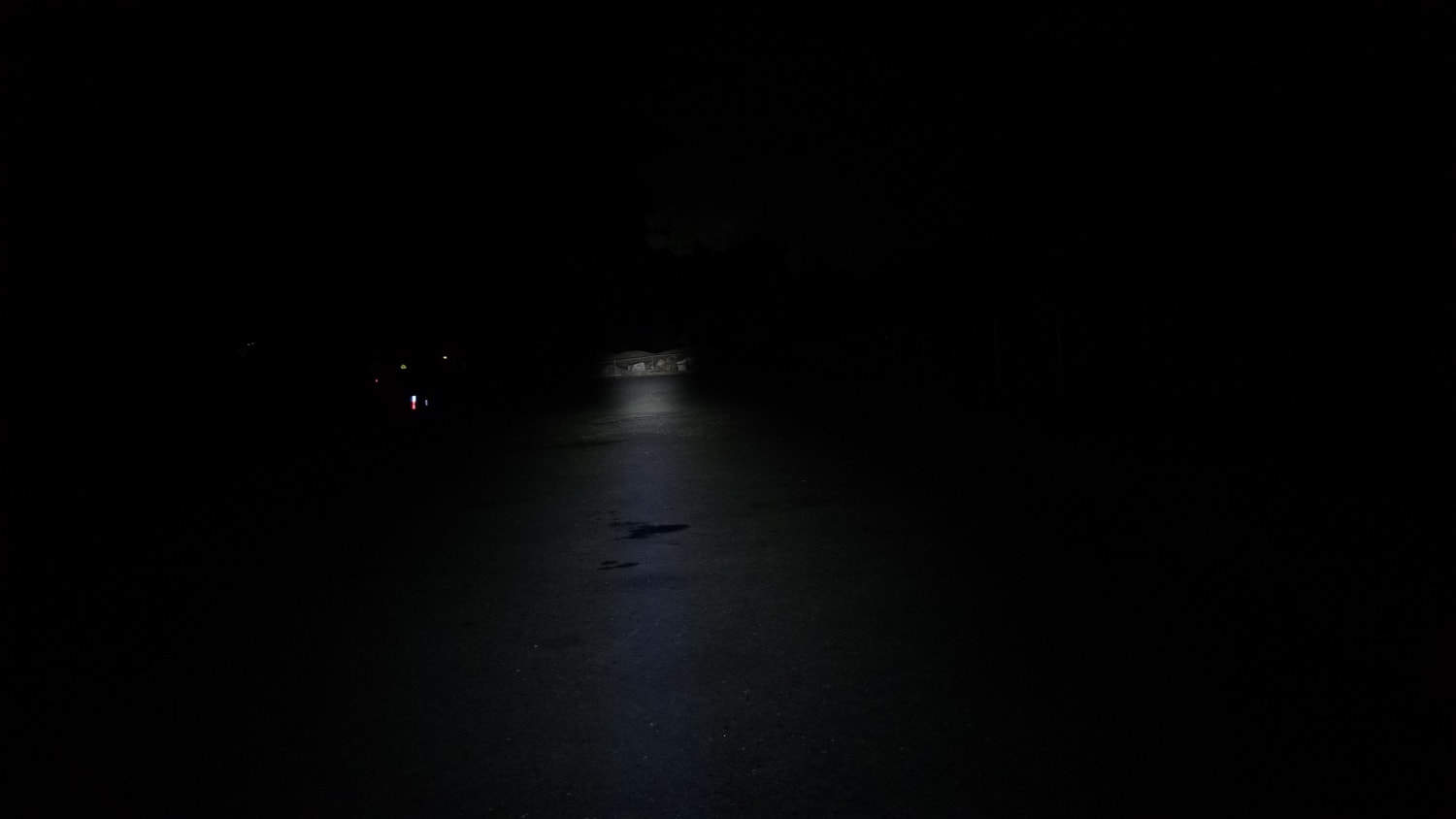
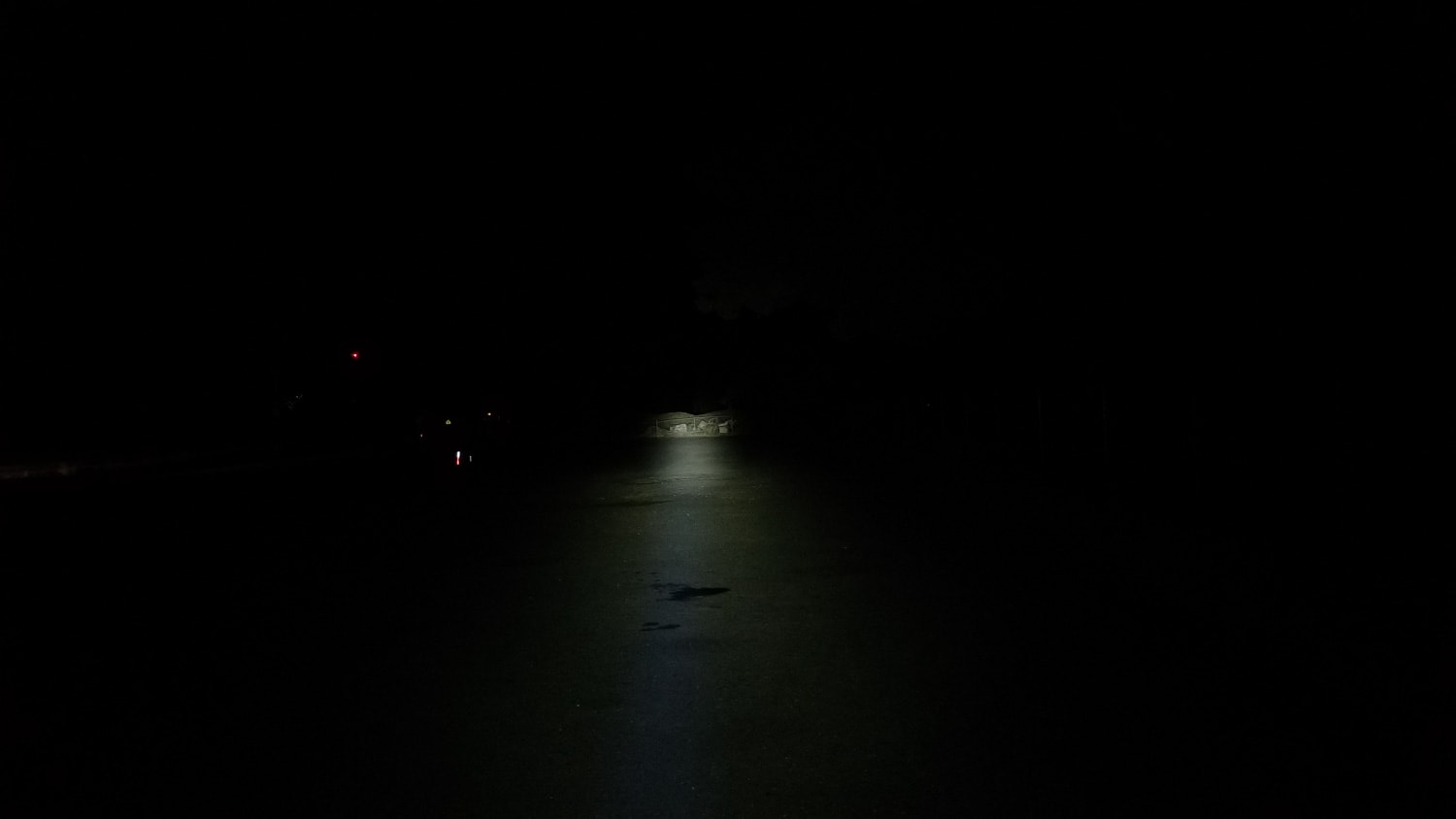
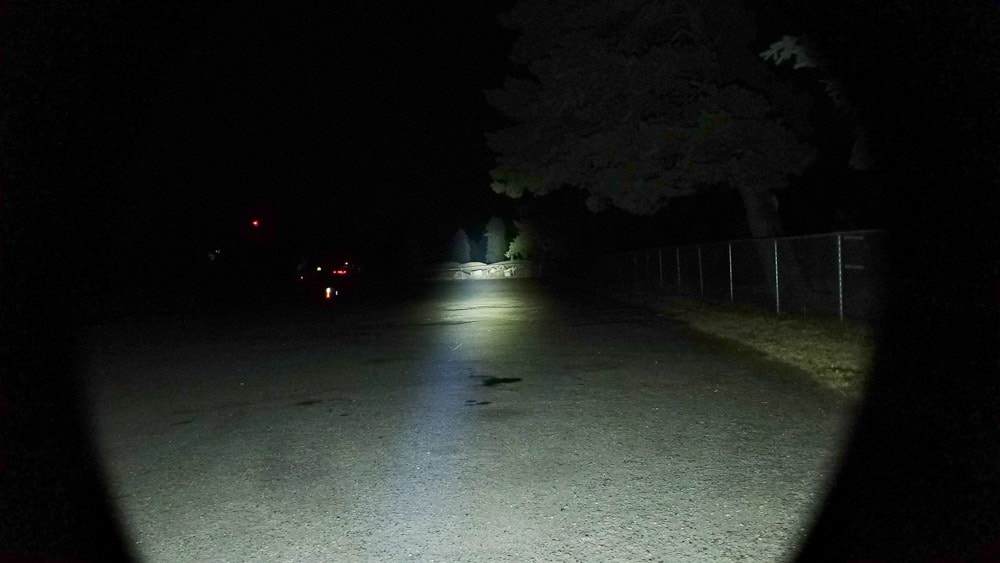
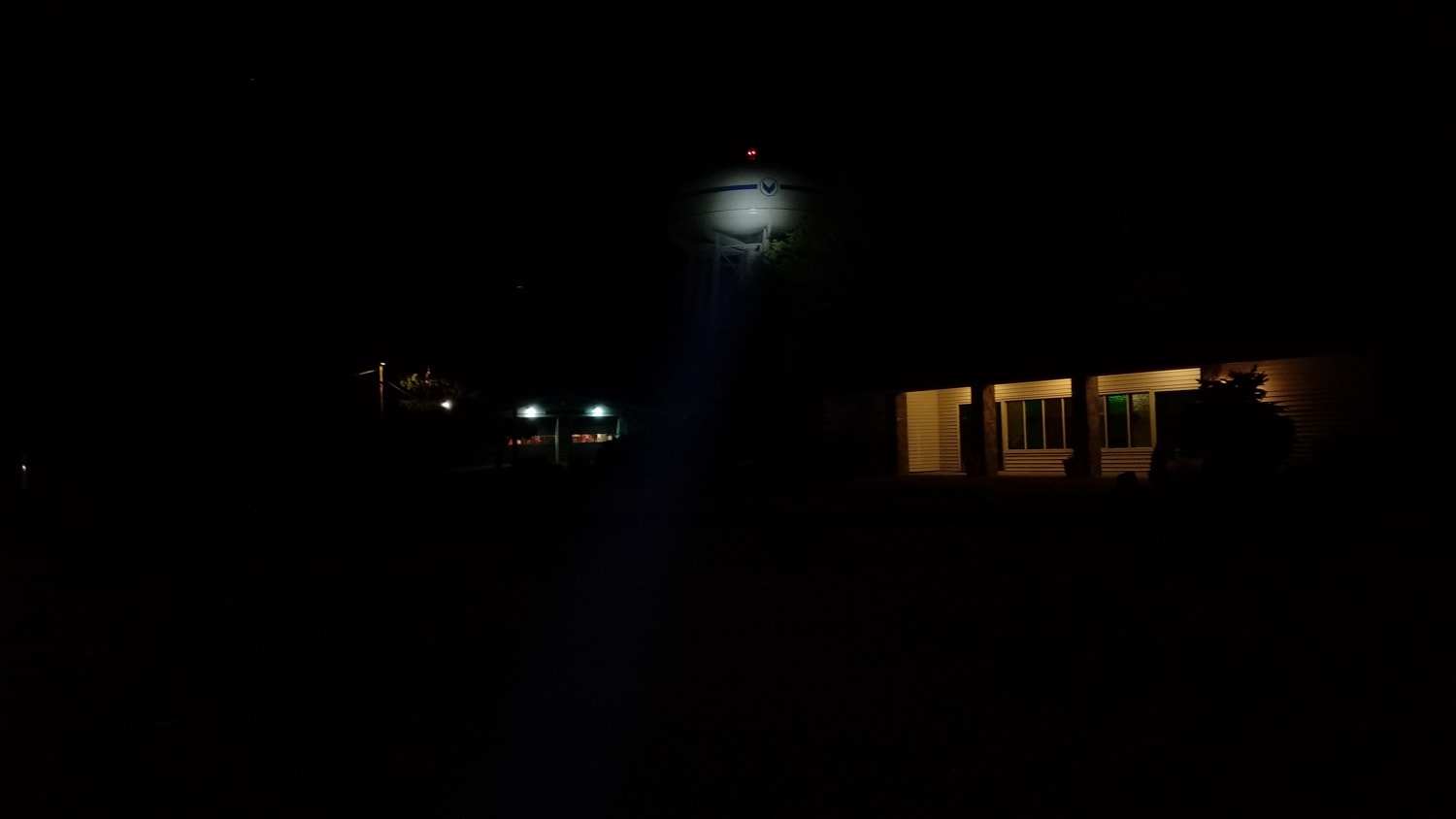
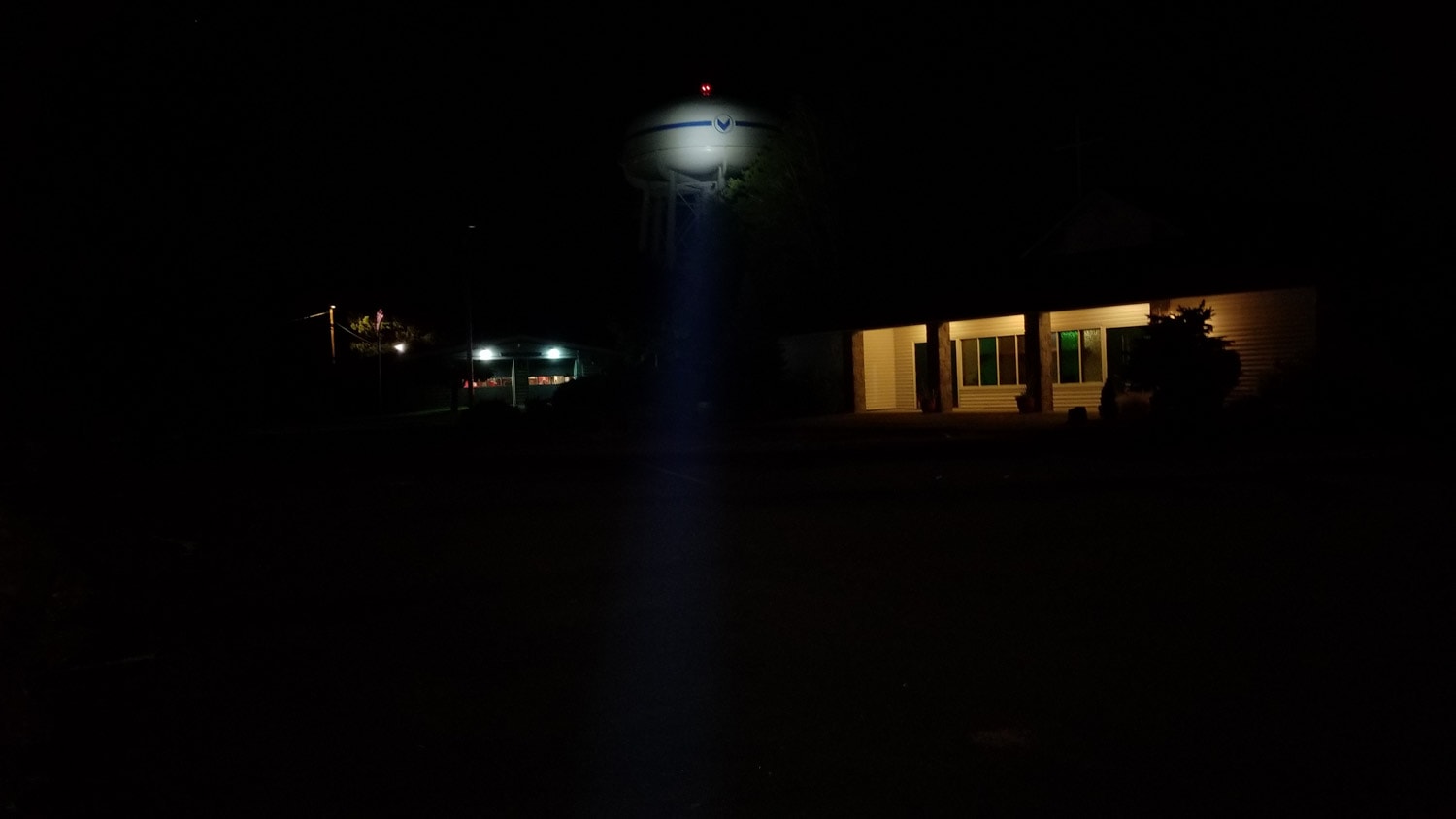
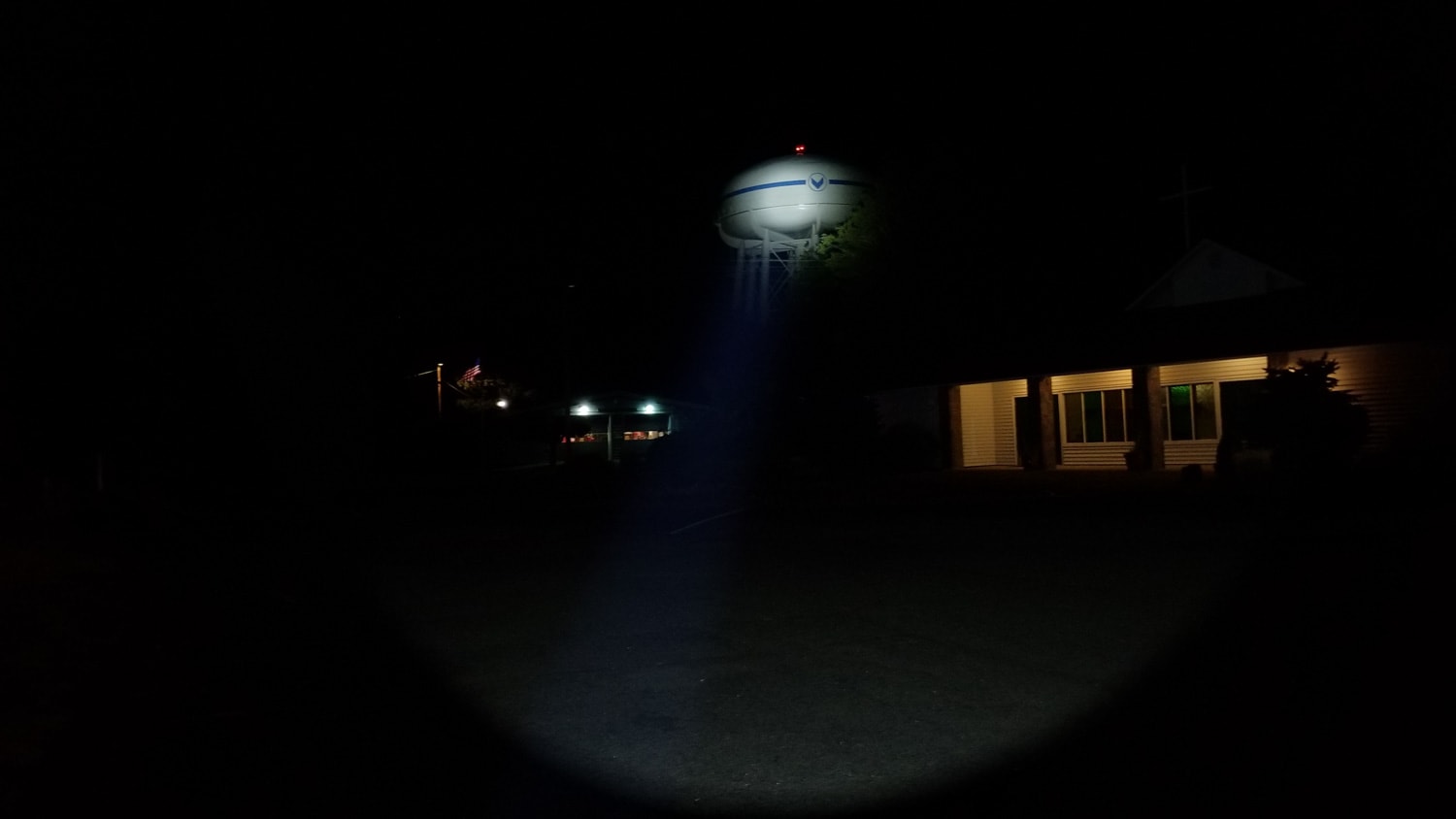
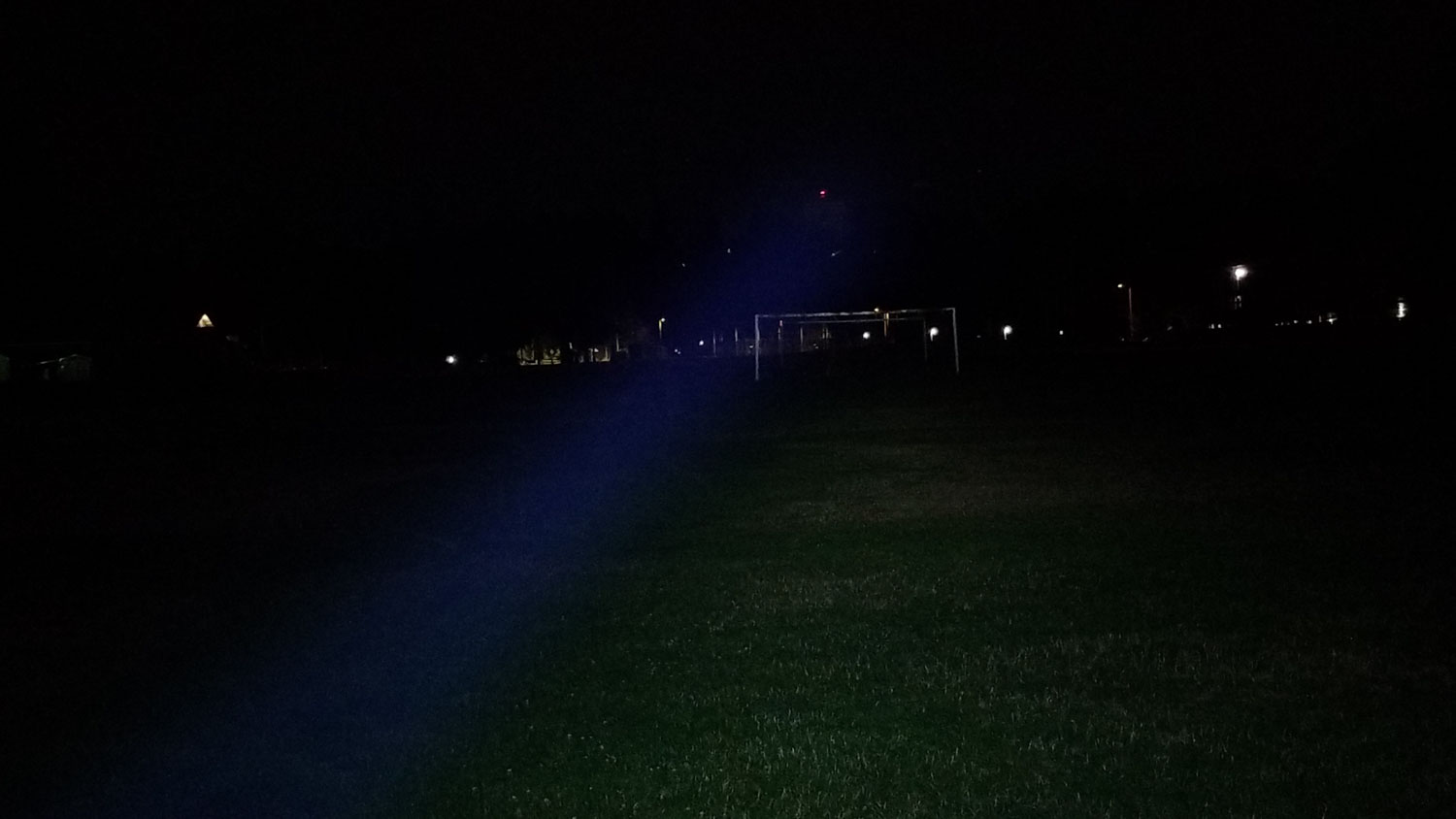
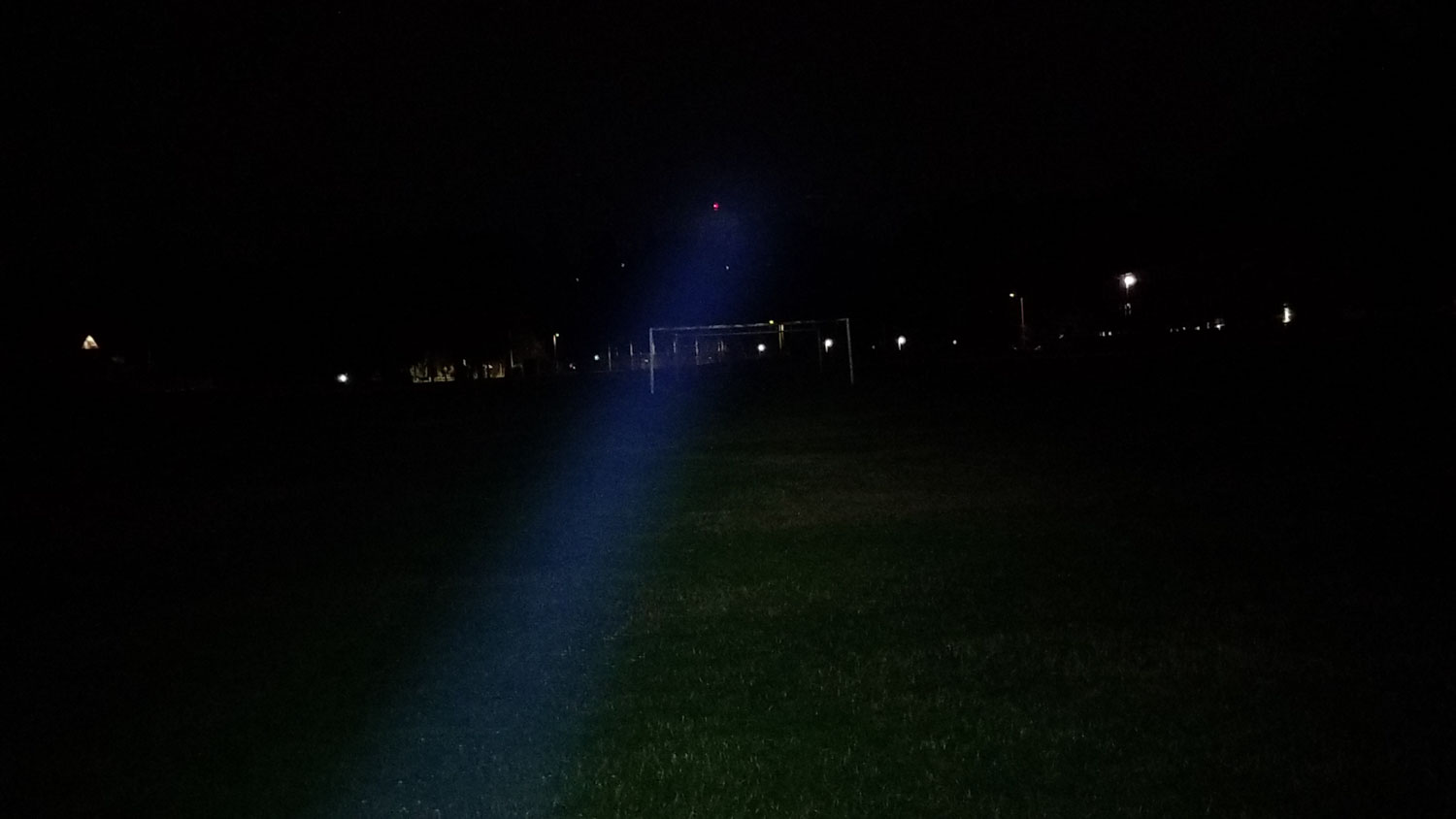
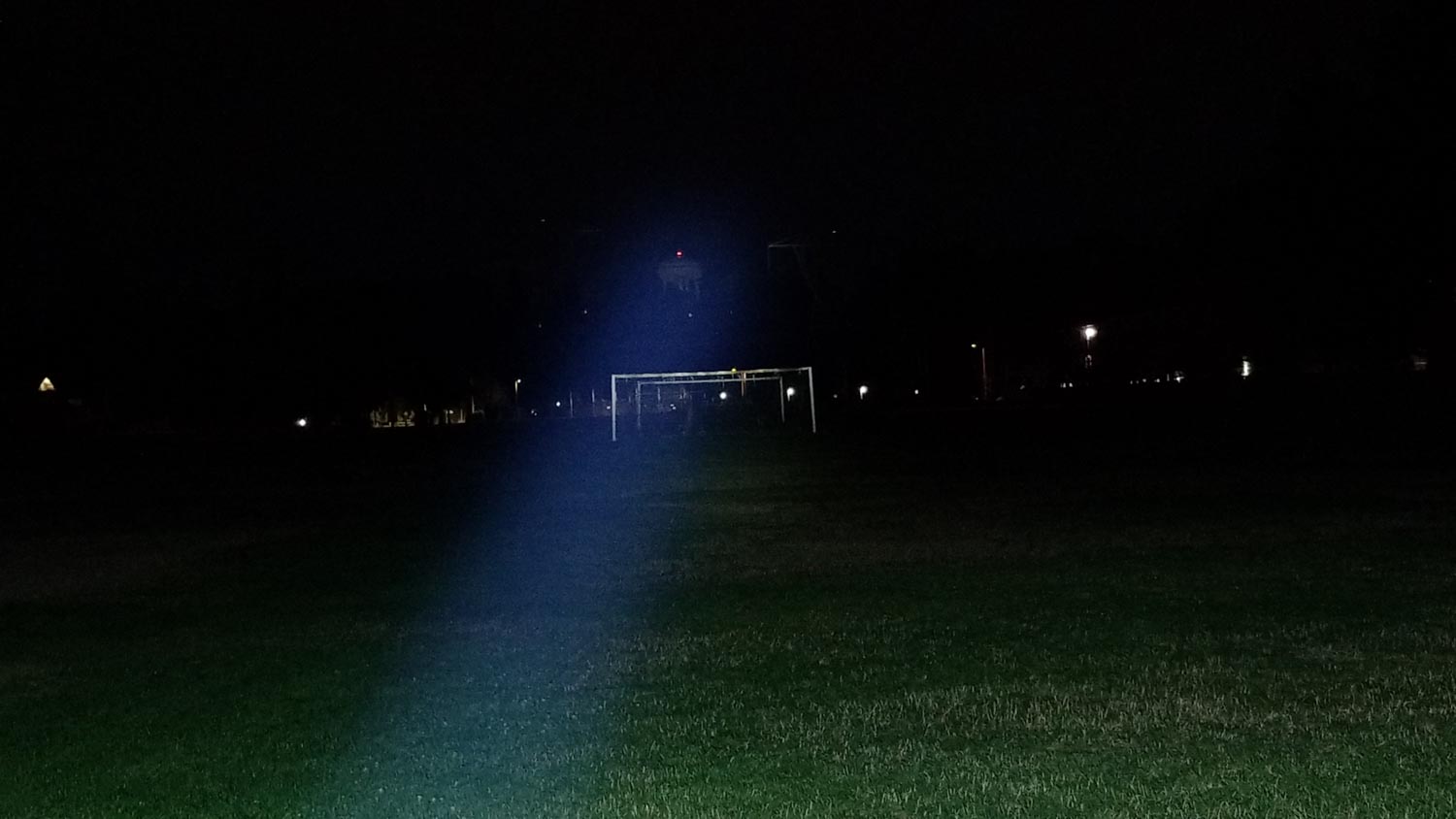
Disclaimer: This flashlight was sent to me for review at no cost by WildTrail. I have not been paid to review, nor have I been holding back on problems or defects.
Final Verdict
Pros
- Gorgeous design!
- Easy to handle for a large light
- Great throw
- Long runtimes
- Easy to disassemble
- Decent build quality
- Power bank capability
- 21700 cells
Cons
- Sharp edges on the battery carrier
- Finishing was a bit rough
- NarsilM is a bit complicated
- Slow charging-really needs PD capability
Explanation on star ratings:
1: Avoid: my phone flashlight would be a better choice – 2: Poor: significant defect or issues, much better options available at the same price – 3: Average: some defects or issues – 4: Good: recommended (minor issues) – 5: Great: highly recommended

4.5 stars: ★★★★⋆
I can honestly say of all the awesome lights I’ve reviewed and tested, I wasn’t as excited about them as I was the WT90. This light is the culmination of years of planning, brainstorming, delays, and production pains, but here it is at last and it’s brilliant! One thing I really love about manufacturers like WildTrail is that they are as passionate and concerned about their lights as their customers are, and they really do embody the enthusiast culture in products like this. Make no mistake, the WT90 is interloping into a very crowded market segment full of great SBT90.2-equipped throwers, but it offers something the others don’t…style.
I mean, like Doc Brown’s DeLorean time machine, if you’re going to build a thrower, do it with style, and this thing looks slick without sacrificing functionality. Performance is as good as expected from an FET-driven SBT90.2, with high Lumen output and very good throw for a sub-90 mm reflector. Remember, this is quite a bit smaller than a BLF GT, Astrolux MF04, or Acebeam K75, with the closest competitor being the MF02S V2 and Acebeam K65 GT. It has excellent sustainability, holding high output for long periods. Anyone used to SBT’s in smaller hosts will be pleasantly surprised with the thermal performance. Plus, with 5000 mAh cells, you can get long runtimes as well.
The build quality is completely acceptable, and although there were some ‘growing pains,’ WildTrail worked with the community and remedied those (at least on my sample). This is a great-performing, easy to handle light that won’t give you tennis elbow after carrying it around for 5 minutes. I wasn’t thrilled about the sharp edges on the battery carrier, NarsilM is still complicated (alas, I get it, though…enthusiast light), the charging is begging for PD, the switch is just meh, and the fit and finish aren’t Acebeam or Fenix-level. However, for the price, I can’t fault it too much. 4.5 stars for the WildTrail WT90. Get one while you still can!
WildTrail WT 90 For Sale
1lumen selects and reviews products personally. We may earn affiliate commissions through our links, which help support our testing.